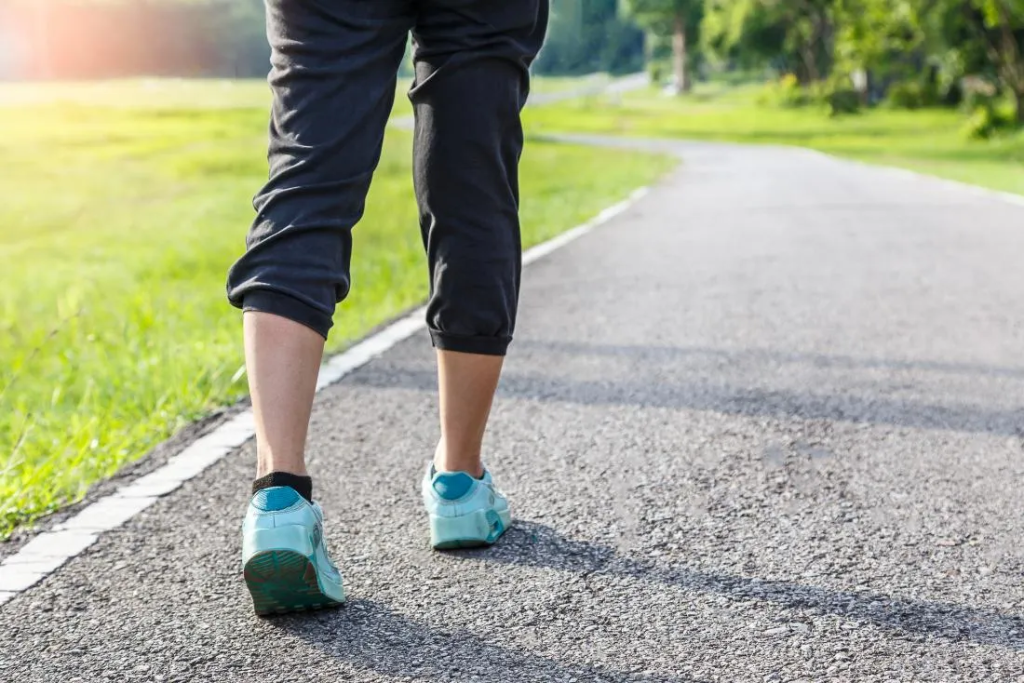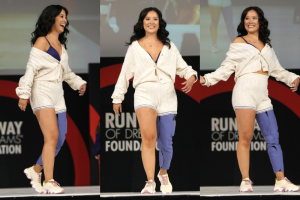
The way you walk can impact every aspect of your life. If your walking is impacted by multiple sclerosis, cerebral palsy, stroke, or any other neurologic condition, gait training exercises can help improve your mobility, balance, and ability to ambulate.
What is gait training?
Your gait refers to your pattern of walking, and gait training refers to the physical therapy treatment that aims to improve walking by addressing the components of gait that are impaired.
Gait training can help reduce the risk of falls and injury. To better understand gait training — and why it’s so beneficial — it’s important to understand the gait cycle.
The gait cycle
The gait cycle refers to the sequence of movements that occur while walking. A single gait cycle begins when the heel of one foot strikes the ground and ends when the same heel strikes the ground again.
Typical gait requires the healthy functioning of several systems in the body, including the nervous, musculoskeletal, cardiovascular, and respiratory systems.
According to Rancho Los Amigos, there are eight phases of the gait cycle, including:

- Initial contact — also referred to as the heel strike phase, initial contact begins when the foot touches the ground. Many healthcare professionals refer to this movement as “heel strike,” since the heel is typically the part of the foot that hits the ground first. However, neurological conditions or limitations in range of motion can impact heel strike and instead cause flat foot or forefoot strike, leading to irregular gait patterns
- Loading response — also referred to as the foot flat phase, the loading response phase refers to how your leg prepares to accept the load of the body (pretty aptly named, right?!). More specifically, the loading response phase marks the point in walking where you transition from shock absorption to single-leg weight-bearing
- Mid-stance — The mid-stance phase marks the beginning of total, single-limb support. At this point in the gait cycle, your “stance limb” is completely responsible for supporting your body weight and staying balanced through your forward movement
- Terminal stance — The terminal stance phase of your gait begins in single-limb support and ends in double-limb support as the opposite limb makes contact with the ground. However, rather than predominantly bearing weight (like in mid-stance), this phase is where your body progresses past the stance foot.
- Pre-swing — The pre-swing phase of your gait occurs in a period of double-limb support — but not for long. During this phase, your body is beginning to prepare itself to transition to the swing phase. But before swing occurs, your body shifts its weight from the forefoot to the toes, to help propel the body forward
- Initial swing — The initial swing phase refers to the point when the leg begins to move forward and you transition to single-limb support on the opposite leg. This phase ends once this foot is parallel to the foot of your opposite leg. Throughout your gait cycle, one leg is always in its swing phase, while the other is in stance phase.
- Mid-swing — The mid-swing phase is part of your gait cycle where your leg actually “swings” forward past your stance leg so that your shin bone is vertical or perpendicular to the ground.
- Terminal swing — The eighth and final phase of the gait cycle is the terminal swing phase. It begins just as the shin bone of your “swing limb” starts to angle out of its vertical position and ends when the foot touches the ground. This completes the full gait cycle!
Who can benefit from gait training exercises?
Anyone who has an abnormal gait can benefit from gait training exercises. Most often, irregular gait can result from:
- Spinal cord injuries
- Stroke
- Neurologic conditions such as multiple sclerosis (MS), cerebral palsy, and Parkinson’s disease
- Brain injuries
- Orthopedic conditions such as osteoarthritis
- Joint injuries or replacements
- Broken bones in the legs or pelvis
- Sports injuries
- Advanced age
Okay, now that we’ve covered the gait cycle, and what can cause irregular gait patterns, let’s learn about exercises to help correct them.
Gait training exercises
1. Knee Extension
Knee extension exercises are a great gait training exercise because they help strengthen our quadricep muscles which are used in both the swing and stance phases of gait..
To perform a seated knee extension exercise, extend your leg in front of you so that it’s parallel to the floor by contracting your quadricep muscles in the front of your thigh.
Once your leg is fully extended, slowly bring your foot back down to the floor. Alternate back and forth between your legs while maintaining good posture.
2. Seated Marching
Seated marching is a great exercise to engage the hip flexor muscles which are primarily active during the swing phase of gait.
To perform seated marching sit on a a stable chair or surface and lift one leg towards your chest while maintaining good posture. Slowly place it back down on the floor. Repeat on your other leg, alternating back and forth.
If you’re interested in adding a challenge, pause at the top for a few seconds. You can also add arm swings to the movement (opposite arm, opposite leg) as if you’re walking in place while seated on the chair.
3. Single Leg Stance
Single-leg stance is a great way to improve balance, stability, and strength for the stance phase of gait.
Start by finding a stable surface, such as a counter or tabletop. Place your hands on the surface and lift one foot off the ground so all of your weight is on the opposite leg. Hold this movement for up to 30 seconds and repeat it on the other leg.
As your balance improves, you can progress this exercise by removing one or both hands from the counter or tabletop and/or closing your eyes to improve proprioception.
4. Sidestepping
Sidestepping can help strengthen the hip abductors which help to stabilize the pelvis during the stance phase of gait.
Start by standing and facing a table or counter. Place your hands on the surface for balance. Stand up straight, engage your core, and step to the side with one leg, then follow with the other leg. Do a few repetitions in that direction and then reverse to the other side.
For an added challenge, you can add an obstacle to step over.
5. Sit-to-Stand
Sit-to-stand exercises not only improve strength needed for walking, but they also enable you to stand up more easily, especially from low chairs or soft couches, further improving your mobility.
Start in a seated position in a sturdy chair, with your feet planted hip-distance apart. Lean forward, bending at the hips. If you’re able, try to avoid using your hands to assist you as you come to a standing position. Push down from all four corners of your feet to maximize stability and balance as you stand. Once standing, reverse the movement by leaning forward as your knees bend and your hips move back towards the chair as you slowly lower yourself back to a seated position.
6. Backward Walking
Backward walking can improve hamstring flexibility, quadriceps activation, and overall coordination. By switching from forward walking, which is a heel-to-toe motion, to backward walking, which is a toe-to-heel pattern, your lower extremity muscles and joints are challenged in new ways, which helps improve your gait.
Start by standing sideways next to a stable surface, such as a countertop or table. Place your closest hand on the surface to maintain balance and stability. Start stepping backward with one foot while maintaining hand contact with the stable surface. Take a few steps backward and then reverse direction.
As you feel more comfortable with this movement, and only if you feel safe doing so, you can progress by removing your hand from the surface or adding ankle weights to increase strength.
Assistive devices to help maintain a regular gait
Though gait training exercises can certainly help individuals with impaired mobility, sometimes an assistive device is utilized to help maintain a regular gait pattern by providing balance and support while walking.
This can be especially true for people with neurologic conditions. The goal of gait training is to improve your gait pattern with or without the use of an assistive device. Sometimes gait training may help individuals transition from one assistive device to another. For instance, from a walker to a cane.
Here are common devices that are helpful for people with irregular gaits:
- Straight cane
- Axillary crutches
- Lofstrand crutches
- Walkers
- Cionic Neural Sleeve
Benefits of gait training
Gait training may help you walk more efficiently, at faster speeds, and for longer periods, which can reduce the risk of falls, and lower your risk of developing conditions such as heart disease and osteoporosis due to increased physical activity.
Increased physical activity can also lead to improved mental health and overall quality of life.
Bionic clothing to improve gait

Bionic clothing, when used in conjunction with gait training exercises, can be a great way to improve walking. The Cionic Neural Sleeve is the first FDA-cleared mobility device to combine the diagnostic power of a multi-million dollar gait lab with the therapeutic power of Functional Electrical Stimulation, or FES for short.
With full leg assistance, the Cionic Neural Sleeve delivers FES to the four major muscle groups: 1) hamstrings, 2) quadriceps, 3) calf, and 4) shin, using adaptive algorithms to deliver stimulation to the muscles precisely when and where it is needed in the gait cycle. The system updates every step to make each step smarter than the last.
In CIONIC’s first multi-site research study, 94% of participants experienced increased ankle dorsiflexion at heel strike, 88% experienced reduced ankle inversion during swing, and there was a combined improvement of 9° across all participants.
Click here to learn more about the Cionic Neural Sleeve.
Other methods to supplement gait training exercises
Gait training exercises and bionic clothing are just a few ways to improve your gait. Here are additional methods your physical therapist may recommend:
- Resistance training to increase muscle mass and overall strength
- Stretching to improve range of motion and flexibility
- Core training to improve stability and posture
- Functional electrical stimulation to target affected muscles
So, there you have it! Exercises, devices, and other methods to improve your gait. As always, be sure to consult with your physical therapist or healthcare provider when trying any new exercises or devices — especially if you’ve suffered from a stroke or injury, or have an underlying disorder that impacts your mobility.





